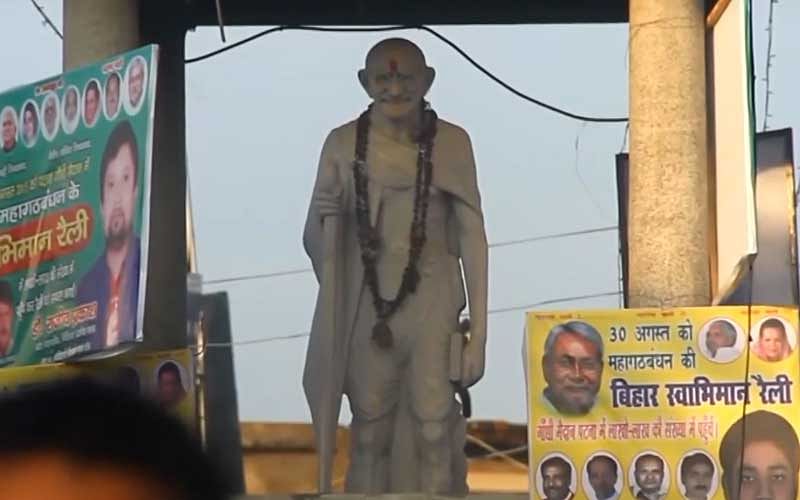
The fields and bylanes of villages and urban settlements that gave birth to the Champaran satyagraha echo with the name of the Mahatma, but along with reverence for the man who shaped India’s freedom is also callous neglect of his legacy.
In a letter to his British disciple Madeleine Slade, who came to be known as Mirabehn, Mahatma Gandhi famously called Champaran the place that introduced him to India.
The 1917 Champaran satyagraha, in which Gandhi spotlighted the plight of indigo farmers, is sometimes known as India’s first civil disobedience movement.
But today, as the country celebrates the 150th birth anniversary of the man who inspired generations with his policy of 'ahimsa' and his principles on life, governmental and public neglect and rampant urbanisation have eclipsed history in more than one place.
The Hazarimal Dharmshala in Bettiah where Gandhi stayed is dilapidated, a huge shopping mall and other commercial establishments dwarfing the structure.
Declared a “protected monument” by the Bihar government and proudly displayed on the “Gandhi circuit” page of the State Tourism Development Corporation, the dharmshala presents a sorry sight.
A swarm of flies from piles of garbage greets visitors, flying in the face of the Swachh Bharat Abhiyan, which draws its inspiration from Gandhi’s emphasis on cleanliness.
Bettiah is now the headquarters of West Champaran district.
The house of advocate Gorakh Prasad, Gandhi’s first stop in Motihari, about 45 km away, is also in a state of utter decrepitude.
However, there are other places where care is taken to preserve the legacy of Gandhi.
“Mahatma Gandhi transformed Champaran, which takes pride in being the place where, in a way, his journey towards attaining unparalleled greatness started,” Brajkishor Singh, secretary of the Gandhi Sangrahalaya memorial and museum in Motihari, told PTI.
The Gandhi Sangrahalaya is one of the numerous places named after the Mahatma in Motihari. There is also the spic and span Bapudham railway station that was inaugurated by Prime Minister Narendra Modi last year.
“It was due to Bapu’s association with the place that people like Khan Abdul Gaffar Khan - fondly called the Frontier Gandhi - took the trouble to visit this remote north Bihar district. Many years later, Subhas Chandra Bose, too, addressed a huge public meeting at the Ramna Maidan here,” Singh, who is in his 90s and is a former state minister, said.
He said Gandhi’s association with Champaran did not end with the satyagraha for the indigo farmers. He also set up a number of ashrams and schools.
“When north Bihar was ravaged by a devastating earthquake in 1934, Gandhi was back with an army of followers, most notable among them being Pandit Jawaharlal Nehru,” Singh said.
“I am thrilled at the thought that this museum is the very spot where Gandhi stood in front of the sub divisional magistrate, refusing to leave the district or secure release by furnishing a bail bond of Rs 100. The calm courage moved the British officer to the extent that he let off the Mahatma despite his reluctance to fulfill any of these conditions”, Singh said.
A stone pillar, designed by the acclaimed Nandlal Bose, stands at the exact spot Gandhi did on April 18, 1917, his first ‘satyagraha’.
Gandhi was unaware of the very existence of Champaran until he visited in 1917, three years after his return to India in 1914.
“I must confess that I did not know then even the name, much less the geographical position, of Champaran, and I hardly had any notion of indigo plantations. I had seen packets of indigo, but little dreamed that it was grown and manufactured in Champaran and at great hardship to thousands of agriculturists,” he later wrote in his autobiography “The Story of My Experiments With Truth”.
He came to Champaran thanks to Rajkumar Shukla, a landowner from Champaran, who was up in arms against the oppression of indigo farmers by the East India Company.
According to Motihari-born academician B N Pandey, it is not just the buildings which have suffered neglect.
“Gandhi’s visit gave Champaran worldwide fame. But many heroes have remained unsung. All know about Rajkumar Shukla…
“(But) Shukla got an audience with Gandhi because of Braj Kishore Prasad, whose daughter Prabhavati married Jayaprakash Narayan. Although he belonged to adjoining Saran, I wonder why Champaran has no landmark named after Braj Kishore babu,” he said.
He added that any number of people should get credit for making the plight of indigo farmers a matter known well enough before Gandhi came here.
“The 150th birth anniversary of Gandhi is indeed an occasion for celebration. So was the centenary of Champaran Satyagraha launched by Bihar government two years ago with much fanfare. But the land awaits due recognition for these unsung heroes whose contributions were less known, but by no means smaller,” Pandey added.